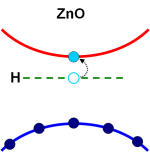Researchers from Germany proved that hydrogen atoms are the ones that interfere with the desired process. Controlled concentration of the hydrogen atoms during the production of zinc oxide is, therefore, the key to the routine use of this material as a semiconductor.

Zinc oxide is the "queen" of the industry - thousands of tons of it are produced all over the world every year for a wide variety of applications. Zinc oxide is used in almost every product from food additives to body tanning agents. It is even a significant semiconductor, although the long-awaited breakthrough in this field has not yet appeared. Perfect doping - an essential feature in the production of semiconductor devices - is still impossible.
A team of chemical scientists from the Ruhr University in Germany, led by Professor Christof Wöll, is much closer to discovering the cause. The team was able to prove, experimentally, that hydrogen atoms are what interfere with the desired process. Controlled concentration of the hydrogen atoms during the production of zinc oxide is, therefore, the key to the routine use of this material as a semiconductor.
Doping (or doping), that is, the controlled introduction of defined foreign atoms into the interior of the crystal lattice of the solid, is the most important factor during the production of semiconductor devices. These foreign atoms can donate an electron to the solid (n-doping), or absorb an electron from it, so that a "hole" is created in it (p-doping). These mobile electrons and holes cause electrical conductivity to be obtained in materials that would otherwise be insulated, that is, the doping process initializes the unique nature of the semiconductor. This usual process in the production of common semiconductors such as silicon or germanium has been extremely problematic for zinc oxide, until now. In particular, it was difficult to obtain a p-doping state, which made it impossible to manufacture semiconductor devices such as transistors or light emitting diodes (LEDs). Such devices require a pn-junction, that is, an intersection between the n-doped and p-doped regions. Because of this, in the field of semiconductors, zinc oxide is currently only used in a limited number of special applications.
Over the past few years, significant improvements have been made in the production of zinc oxide. Only recently was a blue light emitting diode made up of zinc oxide introduced. However, there are still many problems left regarding the drugging process itself. The German researchers were able to identify a significant failure in the production of zinc oxide as a semiconductor. During the experiments, which were actually conducted following the researchers' interest in the catalytic properties of the oxide, they were able to show that hydrogen atoms always give rise to n-type doping. They could reversibly dope the zinc oxide with hydrogen atoms and then remove them by heating.
The scientists were thus able to confirm theoretical observations made back in 2000. They used a special method for measurements at a variety of temperatures to verify the concentration of the appropriate charge carriers. A high practical concentration of these charge carriers is essential in order to obtain the desired electrical properties in the finished devices. It is almost impossible to avoid the presence of hydrogen atom impurities during the production process, so that the acceptance of the desired p-type doping is avoided. The electrons released from the hydrogen atoms to the zinc oxide immediately fill the holes that resulted from the p-doping. A high level of cleanliness, especially a hydrogen-free environment, is therefore a decisive factor in the production of zinc oxide as a semiconductor.
Following their research, the scientists were also able to resolve a scientific controversy: until today, researchers assumed that doping problems in semiconductors resulted from structural defects in the crystalline lattice of zinc oxide, either due to the addition of zinc atoms or due to defects in the arrangement of the oxygen atoms. The findings of this research will form the basis for the future production of more efficient zinc oxide based electrical circuits.

5 תגובות
Along with the correct addition of "someone else entirely", I will add:
Contamination is contamination, and the use of these words (as well as doping) indicates the introduction of some kind of defect into the material. This is due to the fact that those materials into which we inject foreign substances have been previously grown in various processes into a crystalline solid. A crystal has a defined place for each atom that makes it up. Therefore, a perfect crystal = a solid without any foreign atoms except its own, and these only sit in their place. Any deviation from the position of atoms in the crystal or the type of atoms in it impairs its integrity and "purity".
But this is exactly what we are looking for - to introduce foreign atoms, that is, to damage in a very planned way the purity of the crystal. as a fish? 😉
to 3. "Enrichment" is a common term for increasing percentages
The presence of one isotope at the expense of another isotope of
The same substance itself (as in uranium enrichment) - that is, a case
Completely different; Therefore, in my opinion, this term cannot be accepted
for use in the case before us.
Recommend the concept of "enrichment" instead of all the creative solutions (Iloh, HaSama)
Does anyone have any idea what the advantage of a zinc oxide device would be compared to silicone?
What advantages would such a semiconductor have compared to silicon-based devices?